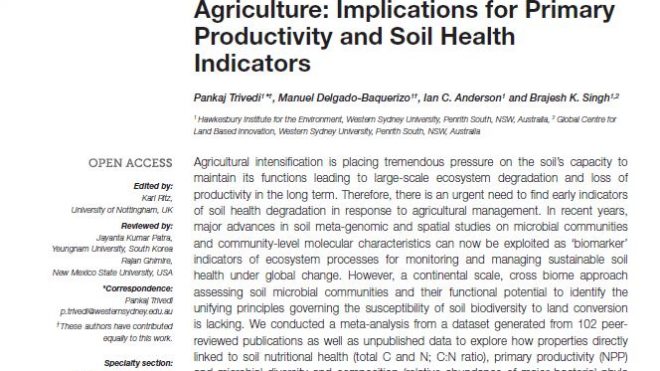Agricultural intensification is placing tremendous pressure on the soil’s capacity to maintain its functions, leading to large-scale ecosystem degradation and loss of productivity in the long term. Therefore, there is an urgent need to find early indicators of soil health degradation in response to agricultural management. In recent years, major advances in soil meta-genomic and spatial studies on microbial communities and community-level molecular characteristics have been exploited to provide ‘biomarker’ indicators of ecosystem processes for monitoring and managing sustainable soil health under global change. However, a continental-scale, cross-biome approach assessing soil microbial communities and their functional potential to identify the unifying principles governing the susceptibility of soil biodiversity to land conversion is lacking. We conducted a meta-analysis from a data set generated from 102 peer-reviewed publications as well as unpublished data to explore how properties directly linked to soil nutritional health (total carbon [C] and nitrogen [N]; C:N ratio), net primary productivity and microbial diversity and composition (relative abundance of major bacterial phyla determined by next-generation sequencing techniques) are affected in response to agricultural management across the main biomes of the Earth (arid, continental, temperate and tropical). In our analysis, we found strong statistical trends in the relative abundance of several bacterial phyla in agricultural (e.g. Actinobacteria and Chloroflexi) and natural (Acidobacteria, Proteobacteria, and Cyanobacteria) systems across all regions and these trends correlated well with many soil properties. However, the main effects of agriculture on soil properties and productivity were biome-dependent. Our meta-analysis provides evidence on the predictable nature of the microbial community responses to vegetation type. This knowledge can be exploited in the future for developing a new set of indicators for primary productivity and soil health.
Region: Not specific
Date published:
2016
Published by:
Frontiers in Plant Science
Type of resource:
Journal article
Resource topic:
Soil
Project/Programme: Not specific
Pest/Disease: Not specific
Pages:
13
File type:
External link (1,854 KB)




